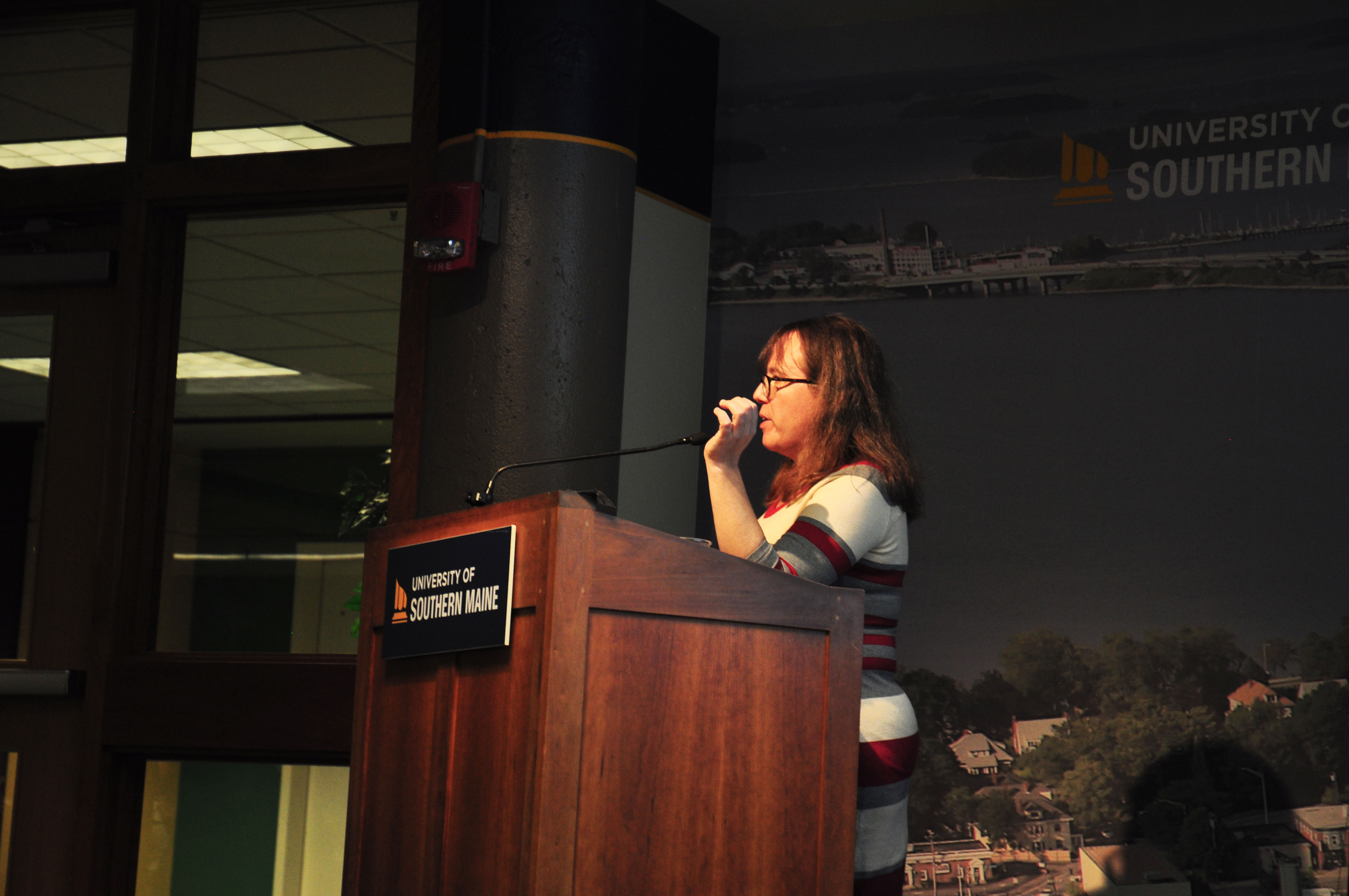By Kate Rogers, Staff Writer
Activist and author Julia Serano visited Glickman Library on invitation by the Women and Gender Studies program at USM to present on the subject of making feminist and queer movements more inclusive. Author of three books, with a PhD in Biology from Colombia and 17 years of genetic and developmental research at Berkeley, Serano is no stranger to what makes humans different–and what makes them the same. With a focus on language, behaviors and social patterns, Julia taught how to recognize all double-standards instead of just a few, so that one may include marginalized people of all kinds in their activism.
Serano began her talk by saying that if she had to describe her identity, it would be, she said, “a bisexual fem tomboy trans woman.” Her purpose was to establish how she often experienced the phenomenon of not fitting into anyone’s box. This leads directly into a definition that is imperative to understanding Serano’s entire point: “Intersectionality is defined as the understanding that different forms of marginalization can intersect with and exacerbate each other.” With this definition comes the knowledge that since a person can fit into more than one type of marginalized group, it is impossible to support only one single group without ostracizing those who fit into others as well as the first. “They’re all intertwined, feminism doesn’t happen in it’s own space,” Serano said. People don’t fit into a binary of “oppressed” and “oppressor,” she said.
As an example, Serano explained the problems of the second wave feminist movement and the gay liberation movement, which happened to coincide with each other. The members of these parties would fight for one while completely ignoring or ostracizing the other. This led to gay women being cast aside for fitting into both categories; they would be scorned by the feminists for supposedly enforcing misogynist ideals, while at the same time facing that misogyny from the gay men. This led to lesbians creating their own movement. However simply creating a new more specific movement didn’t fix the problem.
Defining sexism as discriminating based on any type of sexual or gender identity, Serano offered a few solutions to fighting sexism inclusively. The basis of these solutions was to look at the people instead of the groups. “It’s difficult to talk about a marginalized group without talking about the people,” Serano said.
To start, people should be able to recognize the difference between a “marked” person and an “unmarked” person, as Serano called them. Unmarked people have traits and interests and behaviors that are seen as unremarkable. Marked people have traits that are seen as remarkable compared to the cultural norm and are therefore suspect. There are signs and patterns that can help people identify marked (marginalized) people, and Serano listed many of them. Marked groups are often questioned for being how they are. “If someone asks why are you the way you are, that is a red flag.” Serano said. Marked groups are often asked to explain or define what makes them different. For example Serano gave herself, saying that if the audience later described the event they would likely say that a trans woman had come to speak. While she said there isn’t anything wrong with that, it’s important to note that people would not feel the need to label if a cisgender (non transgender) woman had come to speak. This is one of the double standards put on marginalized groups that is easily recognizable.
Marked groups are often pinned with efforts from society to invalidate them, such as labels of mental incompetence, sexualization, and immorality. This invalidation, however, can also come from other marked people in the form of policing how others deal with their marginalization. One of the examples Serano gave was being accommodating versus being angry. Some activists believe that the best way to be as an oppressed person is angry at the oppressor, and that one should never compromise for anyone. Others decide that they can let things slide, accomodate people who don’t understand by going out of their way to help them.
These are only examples, and all people don’t fit into this binary, but the point is that these types of disagreements cause rifts within communities. Serano believes that this is severely hurting the cause. “If someone has chosen the other side, we are both in a no win situation. We are not enemies,” she said. Learning to let people be who they are however they need to be that is a big step towards being more accepting towards everyone.
As an all encompassing metaphor, Serano compared double standards to stars and constellations. Double standards come in groups. There’s double standards towards specifically women, towards specifically people of color, towards specifically gay men, etc. You can learn to pick those groups of double standards out like you can learn to see the big dipper in a mess of stars. However, there are still thousands of patterns that you aren’t seeing. It is great to learn to recognize those patterns, but the best thing overall is to remember that there is a sky full of stars.
Julia’s three books, her music, her blog posts and much more can be found on her website at juliaserano.com. The Women and Gender Studies program at USM hosts meaningful events on all different topics throughout the year, and keeping an eye on the event calendar and on the bulletin boards is a great way to keep informed about them.

